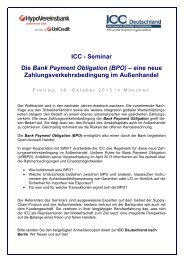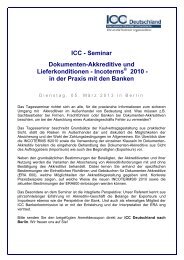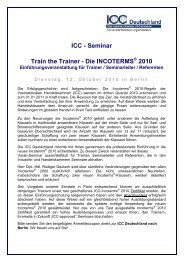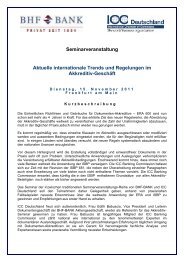Technical Vocational Training: A New Chamber ... - ICC Deutschland
Technical Vocational Training: A New Chamber ... - ICC Deutschland
Technical Vocational Training: A New Chamber ... - ICC Deutschland
You also want an ePaper? Increase the reach of your titles
YUMPU automatically turns print PDFs into web optimized ePapers that Google loves.
3.2 Competency based trainingWhile normally the precondition for attending a vocational school is a formal schooldegree, training at the Handwerk centers is open to anybody interested in thesubject and particularly addresses practitioners from the industry who had so far nothad any chance of receiving any formal qualification in their field of expertise.Practical experience is recognised when deciding on which level of training aparticipant should join. This is a concept that has been discussed for a long time, butimplementation so far had been rare.3.3 Connection to the industryThough not strictly following a ‚dual’ vocational training system, the partners weretrying to emulate this German concept at least to a certain degree. They encouragea training at the centers followed by periods of practical work in the trainees’companies. Through its membership, in particular the National ConstructionAssociation of Sri Lanka, FCCISL can connect those trainees who have not foundemployment yet to the particular industries.3.4 FlexibilityThe training centers are service providers that have to follow the needs of theircustomers. Therefore, a wide range of training modules (more than 60 up to today)have been developed, which can be passed individually or be combined to specificprogrammes. The centers also offer tailor-made solutions. This flexibility isparticularly useful in the context of social programmes, where a certain target groupneeds to be prepared for the job market with a limited amount of resources and in alimited amount of time. It also attracts customers from industry, who want to traintheir staff without too much interruption of day-to-day operations.4 ResultsThe centers have achieved major results for a number of stakeholders:• They were used in the context of social projects, like the rehabilitation offormer rebel soldiers and the re-introduction of former soldiers into the civillife, thereby contributing to issues of national importance.• After initially needing external funds, they have now successfuly implementeda business model which allows them to generate enough turnover to runindependently and even contribute to the finances of its parent organisation.The centers are assets of a proportion that was previously unknown to the<strong>Technical</strong> <strong>Vocational</strong> <strong>Training</strong> as a <strong>Chamber</strong> Service 7/8














